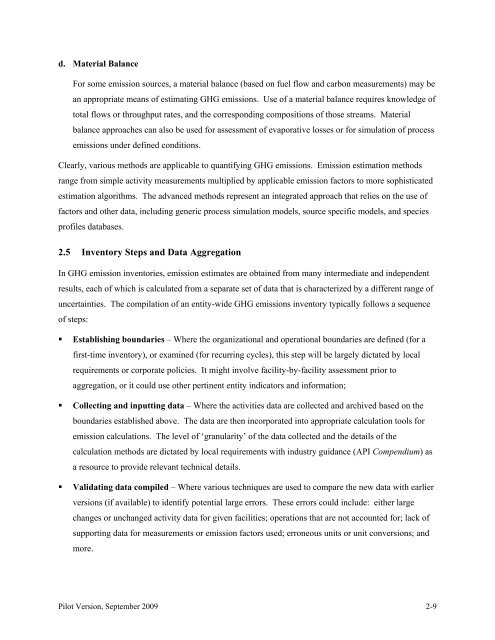addressing uncertainty in oil and natural gas industry greenhouse
addressing uncertainty in oil and natural gas industry greenhouse
addressing uncertainty in oil and natural gas industry greenhouse
You also want an ePaper? Increase the reach of your titles
YUMPU automatically turns print PDFs into web optimized ePapers that Google loves.
d. Material Balance<br />
For some emission sources, a material balance (based on fuel flow <strong>and</strong> carbon measurements) may be<br />
an appropriate means of estimat<strong>in</strong>g GHG emissions. Use of a material balance requires knowledge of<br />
total flows or throughput rates, <strong>and</strong> the correspond<strong>in</strong>g compositions of those streams. Material<br />
balance approaches can also be used for assessment of evaporative losses or for simulation of process<br />
emissions under def<strong>in</strong>ed conditions.<br />
Clearly, various methods are applicable to quantify<strong>in</strong>g GHG emissions. Emission estimation methods<br />
range from simple activity measurements multiplied by applicable emission factors to more sophisticated<br />
estimation algorithms. The advanced methods represent an <strong>in</strong>tegrated approach that relies on the use of<br />
factors <strong>and</strong> other data, <strong>in</strong>clud<strong>in</strong>g generic process simulation models, source specific models, <strong>and</strong> species<br />
profiles databases.<br />
2.5 Inventory Steps <strong>and</strong> Data Aggregation<br />
In GHG emission <strong>in</strong>ventories, emission estimates are obta<strong>in</strong>ed from many <strong>in</strong>termediate <strong>and</strong> <strong>in</strong>dependent<br />
results, each of which is calculated from a separate set of data that is characterized by a different range of<br />
uncerta<strong>in</strong>ties. The compilation of an entity-wide GHG emissions <strong>in</strong>ventory typically follows a sequence<br />
of steps:<br />
• Establish<strong>in</strong>g boundaries – Where the organizational <strong>and</strong> operational boundaries are def<strong>in</strong>ed (for a<br />
first-time <strong>in</strong>ventory), or exam<strong>in</strong>ed (for recurr<strong>in</strong>g cycles), this step will be largely dictated by local<br />
requirements or corporate policies. It might <strong>in</strong>volve facility-by-facility assessment prior to<br />
aggregation, or it could use other pert<strong>in</strong>ent entity <strong>in</strong>dicators <strong>and</strong> <strong>in</strong>formation;<br />
• Collect<strong>in</strong>g <strong>and</strong> <strong>in</strong>putt<strong>in</strong>g data – Where the activities data are collected <strong>and</strong> archived based on the<br />
boundaries established above. The data are then <strong>in</strong>corporated <strong>in</strong>to appropriate calculation tools for<br />
emission calculations. The level of ‘granularity’ of the data collected <strong>and</strong> the details of the<br />
calculation methods are dictated by local requirements with <strong>in</strong>dustry guidance (API Compendium) as<br />
a resource to provide relevant technical details.<br />
• Validat<strong>in</strong>g data compiled – Where various techniques are used to compare the new data with earlier<br />
versions (if available) to identify potential large errors. These errors could <strong>in</strong>clude: either large<br />
changes or unchanged activity data for given facilities; operations that are not accounted for; lack of<br />
support<strong>in</strong>g data for measurements or emission factors used; erroneous units or unit conversions; <strong>and</strong><br />
more.<br />
Pilot Version, September 2009 2-9

















